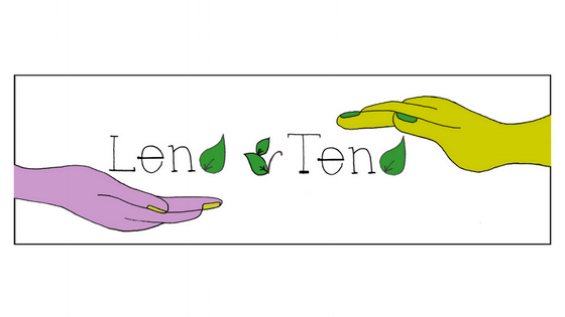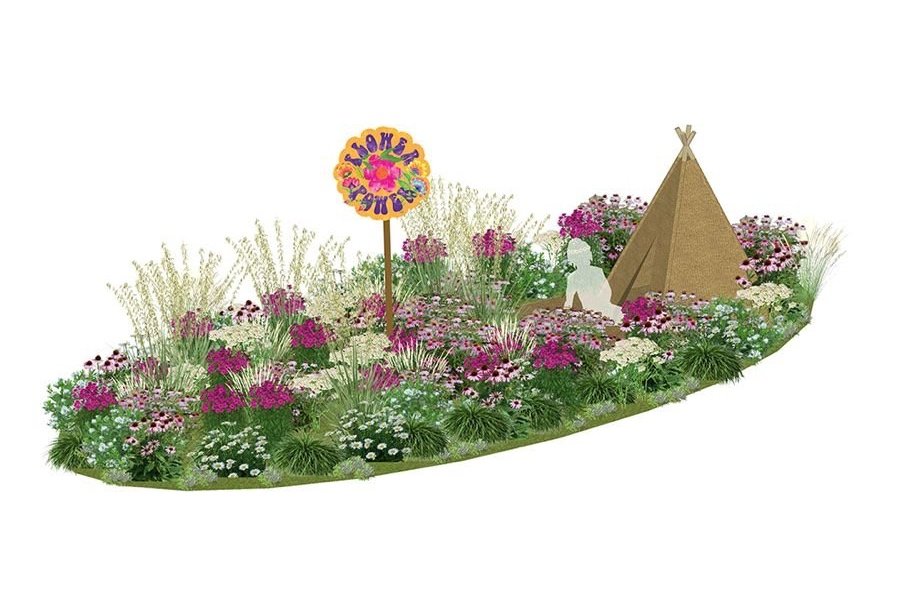GROWING NOSTALGIA: Timeless Daisies, Fashion and Festival Vibes & Vibrant Gardens with Award-Winning Designer Kathryn Cox
On an unseasonably hot Saturday in late September I met with award-winning garden designer Kathryn Cox at Beckenham Place Park and we chatted about her design philosophy, blending the inside out, filling gardens with colour whilst being mindful of biodiversity and sustainability.
What a day for it! The perfect day to admire Beckenham Place Park gardens with Kathryn Cox.
Meanwhile, Summer flowers might be fading but one that continues to enchant no matter the season is also emblematic of a resurgence of all things 90s, and what symbolises this retro revival? The humble daisy.
Borrowed from the 60s counterculture, this iconic bloom is now embraced by Gen Z and Millennials (who are currently seeing trends come full circle for the first time), proving that the daisy is ever-blooming.
Couldn't get a ticket to the comeback tour? Pinterest has wall to wall fan-created art
But the daisy isn’t just an empty nostalgic emblem—it’s a bold fusion of peace, love, and rebellion.
Decades before the 90s alternative scene brought us grunge and hip-hop, Woodstock Farm Music Festival became the cultural epicentre for ground breaking music, peace and defiance where the daisy was a symbol of the Flower Power movement—representing hope and nonviolence amid the political upheaval of the Vietnam War.
Today groups like Gardeners for Palestine continue an equally powerful legacy, using their love of gardens and nature as peaceful protests against injustice, proving the daisy’s message of peace and defiance lives on.
Read more via Radicle: An alternative gardening newsletter from @decolonisethegarden https://radicle.substack.com/p/gardeners-for-palestine
Ultimately, standing tall as a timeless icon of simplicity, love, and rebellion. Its enduring beauty and versatility continue to make it a symbol of hope, resilience, and the potential for a more compassionate world.
This lasting connection between the daisy, rebellion, and peace continues to resonate across art, fashion, and gardening.
At the RHS Hampton Court Palace Garden Festival 2024, garden designer Kathryn Cox, took this love for Woodstock a step further with the inspired ‘Flower Power Field’.
Flower shows can get pretty raucous, no wonder the RHS Hampton Court Palace Garden Festival needed a chill-out zone, and Kathryn Cox delivered just that. Her 'Flower Power Field' balanced the dynamic energy of sensuous atmospheric ornamental grasses with a rainbow tapestry of Asteraceae, creating the perfect laid-back escape featuring a teepee festooned with Daisy chains and illustrated ‘Flower Power’, ‘Peace’ and ‘Love’ signs by artist Katiemo London. The garden created a true chill-out zone amidst the festival's buzz.
But how did she pull off such a natural-looking garden in a controlled environment like a festival? Kathryn shares her approach:
"Every plant’s position was planned using a kaleidoscope design to plan the colour, but the key was allowing them to intermingle at different heights and grow naturally, giving the impression of a garden that has been there for years."
She emphasises using native and mature plants and blending plant heights through strategic layering.
Kathryn's plan for the garden.
If you’re looking to recreate this effortless look at home, Kathryn suggests starting with native and mature plants, arranging them -disregarding height order, to mimic nature. You can easily source similar perennials like daisies, grasses, and asters at your local garden centre for a relaxed, naturalistic vibe in your own space.
Feeling Inspired? Get the Look
The daisy to me is what a child’s drawing of a flower looks like, but the humble ubiquitous daisy is actually one of the most diverse species of flowering plant, (only orchidaceae has more). Did you know, the daisy, part of the Asteraceae family, includes sunflowers, chrysanthemums, dahlias, as well as asters -perennials that make a predictable comeback year after year making them not just nostalgic but daisies also offer a low-maintenance, low cost and eco-friendly way to enjoy blooms season after season.
To research further about the favoured flower read more about Asters and Kathryn’s garden here: https://www.rhs.org.uk/shows-events/rhs-hampton-court-palace-garden-festival/news/2024/all-about-asteraceae
The daisy’s revival isn’t just blooming in gardens. In fashion, this emblem of rebellion and simplicity is back in style. Yet, as fashion revisits past trends, there’s an environmental cost where fast fashion churns out replicas of old styles, a reminder that not all nostalgia is sustainable. Current face of fast fashion, Gen Z icon Charli XCX has recently been criticised for a not-so-green ‘Brat Green’ collaboration with H&M, contradicting the anti-consumption message from her latest album.
Eco-conscious voices like environmentalist Mikaela Loach, offer an alternative, advocating for preloved fashion and sustainable choices on platforms like Vinted. Also, fyi gardeners! Your flannel shirts and combat pants are trending as #GardenCore is now very fashionable!
Joking aside, gardening is a great hobby that can distract from overconsumption while feeding into nostalgia. Daisies offer an eco-friendly, low-maintenance way to enjoy vibrant blooms year after year.
As Kathryn says
"Perennials like daisies are perfect for a long-lasting, sustainable garden. They’re easy to care for, contribute to biodiversity, and bring beauty to any space."
Planting daisies or any Asteraceae family members this autumn—whether in a garden or window box—you can reconnect with nature in a sustainable way while supporting the environment and biodiversity. Instead of contributing to fast consumption cycles, gardeners can reconnect with nature, much like past generations. By cultivating diverse, native plants, we honour the past while embracing a sustainable future.
“The garden aimed to remind us of the collective spirit of flower power. Be it through nature, music or art, from Woodstock to the current day, we call spread the peaceful message of flower power and help make the world a better place”.
Next spring, enjoy the vibrant blooms of these timeless flowers, as the daisy—like pop culture—always comes full circle.
To dig a little deeper, I met with Kathryn for a chat and some tips for you Lenders and Tenders.
Q&A
What’s the difference between a garden designer and a landscaper?
Kathryn: A garden designer creates the concept for the space, often working with a blank canvas or an overgrown area, imagining what it could become. The landscaper, ideally working closely with the designer, brings that vision to life, by following detailed plans and drawings to build the garden.
How can Lenders and Tenders collaborate when sharing a garden?
Kathryn: Treat the Lender as the client. Understand the garden’s aspect—where the sun hits, what thrives—and incorporate your ideas. “I believe in the power of collaboration” [which can foster teamwork in garden creation, even if the Lender isn’t doing any of the work, it’s important that both parties keep a line of communication to result in a space that works for both parties, balancing each others’ preferences and practicalities. Kathryn keeps meticulously organised notes and photo records, at the very least, photograph as much as possible and fill in and share the Lend and Tend garden-sharing agreement for both Lend and Tender’s records.]
How can you design for a positive social atmosphere in shared garden spaces?
Kathryn: It starts with finding the hero sunspot—where the light is best at different times of day. Plan seating and communal areas where people naturally want to gather, whether it's for a morning coffee or evening drinks. Think of your garden as a holiday escape—relaxing and inviting.
Tell us about your RHS Flower Power garden design.
Kathryn: My design, ‘The Flower Power Field’, was tribute to Woodstock festival. I created an imaginary space to chill out between bands, with colourful Asteraceae and a teepee. The garden featured a kaleidoscope-inspired planting design, with repeating perennials and ornamental grasses to create a field-like, dynamic feel.
Any tips for designing small or challenging garden spaces?
Kathryn: In small gardens, light conditions can vary within short distances. It's important to observe how the light changes throughout the day and plan accordingly. Also, be mindful of plant sizes as they grow and consider sustainability—retain mature plants where possible to maintain biodiversity and reduce costs.
What trends do you see in garden design?
Kathryn: Naturalistic gardens, where people feel immersed in nature, are popular. Younger clients are investing in their gardens, focusing on sustainability and aftercare. There’s a shift away from quick makeovers towards creating lasting spaces that grow with the homeowner.
So it's not just about going in and creating a beautiful garden like we're on a TV show, but actually ensuring our clients, whatever age they are, have a garden that suits their needs in terms of their skill level.
To support a naturalistic garden see if there's mature plants that you can retain. Also thinking about wildlife is really important because you might have a really lovely hedge in the back of the garden that families of birds have been nesting in for years. So when you go into a garden, as with Lend and Tend, look at the wildlife. How is the wildlife using the garden? Are there birds? How can you sustain that wildlife because it's their home.
Any other tips for embarking on a garden-sharing project?
The thing that's always really important is actually, the more overgrown it is, probably the more wildlife there is! So it's something to be really mindful of when you're going in, as with Lend and Tend, and actually just kind of getting to know not just the garden, but the wildlife that inhabit it.
Look at the plants that are there, log them, make sure you're not accidentally ripping something up that you want to keep. But also I think in terms of biodiversity and sustainability, it's really important to bring water into the garden.
So it could be as simple as having a massive bowl, or an old plant pot that you could put some resin in the bottom to waterproof so you can put water in. Water also adds to the garden and the atmosphere of the garden which will also help the wildlife that may already be there.
The next time you get a chance to hang out in a (hopefully, Shared) garden why not dive into the cultural roots of Woodstock with Pete Fornatale’s *Back to the Garden: The Story of Woodstock and How It Changed a Generation available from https://www.waterstones.com/book/back-to-the-garden/pete-fornatale/9781416591207 and local libraries and independent bookstores.
Further credits:
Sponsors: RHS & London College of Garden Design.
Designed By: Kathryn Cox x Acacia Gardens
Artwork: Katiemo London
Build Sponsors: Acacia Gardens
Homeware Sponsor: Ella James
Photography: Sophie Claire Gardens
Size: 15m²
London College of Garden Design https://www.lcgd.org.uk







